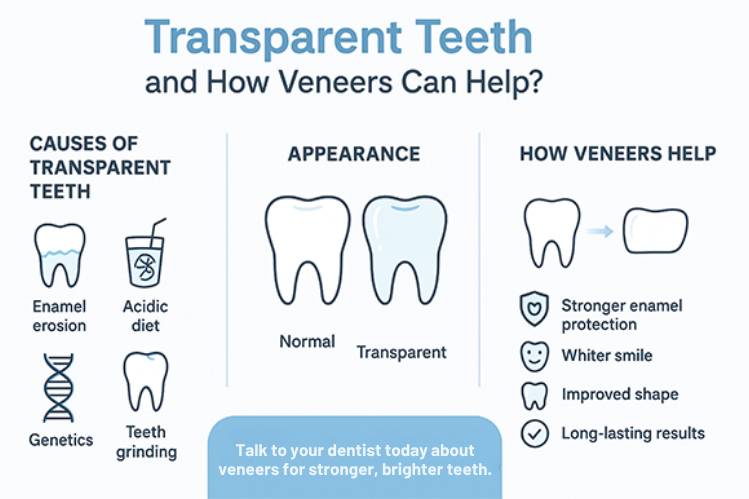
Table des matières
Des dents transparentes ? Vous n’auriez jamais pensé entendre ou rechercher cette expression sur Google, n’est-ce pas ? Eh bien, croyez-le ou non, c’est tout à fait… Phénomène courant. Un jour, vous vous regardez de trop près dans le miroir et paf ! Ça vous frappe… Avez-vous les dents translucides ? Pourquoi tes dents ont l'air vitreuses ? Elles vont se casser comme du verre maintenant… quoi ?!
Croyez-moi, ça peut paraître alarmant, mais ça ne l'est pas. L'explication est très simple, et mieux encore, c'est… C’est un problème traitable. Alors, examinons les causes, les traitements et les précautions à connaître si vous avez les dents transparentes.
Que sont les dents transparentes ? (H2)
L'émail est cette couche externe dure et brillante qui donne à vos dents un aspect lisse et blanc. Il est en fait plus résistant que L'os est constitué de tissu conjonctif, mais une fois qu'il commence à s'amincir, la lumière peut le traverser. C'est à ce moment-là que les bords commencent à paraître légèrement transparents.
En résumé, des dents transparentes signifient que votre émail est moins épais qu'avant. Vous pourriez remarquer que le bout de vos dents est plus visible. Les dents de devant ont un aspect légèrement vitreux. C'est encore plus visible à la lumière vive.
Au premier abord, vous pourriez penser qu'il s'agit simplement d'un problème esthétique. Mais le problème peut être plus profond. Cela conduit à Émail fissuré et ébréché.
Comment savoir si vous l'avez
Vous vous demandez si l'émail de vos dents s'amincit ? Voici quelques signes révélateurs :
- Le bord de vos dents paraît transparent, bleuâtre ou vitreux.
- Vous ressentez une sensibilité soudaine en mangeant ou en buvant.
- Vos dents paraissent ternes ou moins brillantes qu'avant.
- Elles semblent plus fines, irrégulières ou légèrement fragiles.
Si vous avez remarqué une combinaison de ces symptômes, il est conseillé de consulter votre dentiste pour un examen plus approfondi.
Causes des dents transparentes
Il n'y a pas qu'une seule raison ; généralement, c'est une combinaison d'habitudes, d'alimentation, voire de facteurs génétiques. Voici quelques-unes des causes les plus fréquentes. inclure les éléments suivants.
- L'érosion acide est l'un des principaux responsables. Pensez aux sodas, aux boissons aux agrumes, au vin et même à l'estomac. L'acide issu du reflux. Tout cet acide provoque lentement une érosion de l'émail.
- Il y a ensuite le brossage excessif , qui ressemble à une bonne habitude devenue mauvaise. Si vous frottez votre visage trop fort, Si vous frottez vos dents comme si vous polissiez du métal avec une brosse à poils durs, vous usez en réalité la couche d'émail.
- Le grincement des dents (ou bruxisme) joue également un rôle important. Cette pression et ce frottement constants lentement L'émail s'amincit. Certaines personnes ne s'en rendent même pas compte, surtout pendant leur sommeil.
- Il ne faut pas non plus négliger la génétique . Certaines personnes naissent tout simplement avec un émail dentaire plus fin. C'est la faute à la biologie. pour celui-là.
- Et bien sûr, les carences nutritionnelles. Un faible apport en calcium et en vitamine D peut fragiliser l'émail de vos dents. plus faible.
- Ajoutez à cela la sécheresse buccale ou certains médicaments, et c'est comme une érosion lente et insidieuse dont on ne se rend pas compte. jusqu'à ce que ce soit visible.
Dans la plupart des cas, la perte d'émail se produit lentement, et on ne s'en rend compte que lorsqu'elle est déjà visible.
Pourquoi c'est plus important que vous ne le pensez
Les dents transparentes ne sont pas qu'un problème esthétique. Lorsque l'émail s'amincit, les dents perdent leur protection.
Sans cette barrière, des choses du quotidien comme l'eau froide, le café chaud ou une friandise peuvent provoquer des douleurs ou une sensibilité. Les dents peuvent se tacher plus facilement, voire s'ébrécher simplement en mâchant.
Alors que cela peut commencer par un simple problème d'apparence, c'est en réalité la façon dont votre corps vous avertit : votre émail a besoin d'aide.
Traitement des dents translucides
Les solutions cosmétiques pour un émail fin dépendent de l'importance de la perte d'émail. Voici ce que votre dentiste pourrait vous suggérer :
Collage dentaire
Commençons par le plus simple. Le collage dentaire peut être utile si vos dents ne sont pas gravement endommagées et que vous souhaitez simplement… Vous avez besoin d'une fine couche protectrice, ou si votre émail dentaire est légèrement ébréché ? Ce traitement est rapide et indolore. Votre dentiste recouvrira la partie endommagée de votre dent d'une résine de la couleur de votre dent. Cela permettra de restaurer sa forme. et la solidité de votre émail.
Couronnes
C'est l'une des options les plus protectrices. Les couronnes sont des coiffes placées sur les dents existantes pour les recouvrir. Les recouvrir complètement. Cela permet d'éviter tout dommage supplémentaire. Les couronnes en porcelaine sont conçues pour se fondre parfaitement avec le reste de vos dents. Ce traitement est particulièrement adapté aux personnes souffrant de dommages importants et d'une perte d'émail dentaire.
Facette dentaire
Les facettes dentaires en porcelaine sont peu à peu devenues l'un des traitements les plus recherchés. Vous vous demandez pourquoi ? Beauce peut transformer radicalement l'apparence de votre sourire. Ces produits sont durables et offrent un résultat rapide. Résultats. Ce sont de fines coquilles en porcelaine (et non des coiffes comme les couronnes) réalisées sur mesure pour s'adapter à la face avant de vos dents. Elles masquent la translucidité, renforcent l'émail et vous redonnent un sourire éclatant et uniforme.

Placages pour émail fragile
Les facettes dentaires sont excellentes pour les personnes qui souhaitent une transformation complète de leur sourire. Le collage dentaire, quant à lui, est idéal pour les petites imperfections. Pour corriger les imperfections dentaires, on utilise des couronnes dentaires pour les dents qui s'érodent. Les facettes dentaires peuvent être, et sont généralement, appliquées sur les dents endommagées. Toutes vos dents. Une fois posées, elles protègent vos dents de l'érosion et corrigent instantanément cet aspect translucide.
Elles contribuent à prévenir les dommages futurs car la facette agit comme une armure pour vos dents. Avec de bons soins, elles peuvent durer. 10 à 15 ans, parfois plus.
C'est un de ces traitements qui ne se contente pas de régler le problème, il vous redonne le plaisir de sourire. L'inconvénient pour certains pourrait être le rasage des dents , mais cela n'est pas nécessaire dans tous les cas.
Remèdes maison pour prévenir les dents transparentes
La meilleure chose que vous puissiez faire pour vos dents est de préserver au maximum l'émail. Si vous commencez tout juste à voir Dès les premiers signes d'amincissement, agissez dès aujourd'hui pour ralentir le processus et peut-être même stopper les dommages.
- Commencez par prendre la simple habitude de boire de l'eau tout au long de la journée. Cela permet de garder votre bouche hydratée et favorise… La salive, et élimine l'excès d'acide.
- Se brosser les dents tous les jours est important, mais il est tout aussi important de le faire en douceur. Se brosser les dents avec une brosse dure est néfaste. Le brossage peut fragiliser l'émail de votre peau.
- Utilisez un dentifrice fluoré. Le fluor aide à reminéraliser l'émail, comblant ainsi progressivement les fissures. dents.
- Une alimentation saine renforcera vos os, notamment l'émail. Mais éviter les aliments sucrés et acides protège également. la surface des dents.
Les dents transparentes sont-elles un problème permanent ?
Pas exactement. Une fois l'émail disparu, il ne repousse pas, mais cela ne signifie pas que vous êtes condamné à avoir les dents transparentes. Pour toujours. La dentisterie moderne peut restaurer l'apparence et la sensation de votre sourire et stopper net les dommages.
Les facettes dentaires sont souvent la solution privilégiée. Elles redonnent de l'éclat, de la solidité et, honnêtement, beaucoup de confiance en soi. De même, si vous remarquez l'apparition d'un voile vitreux sur les bords, n'attendez pas qu'il disparaisse. Prenez rendez-vous pour un contrôle. Plus tôt vous découvrirez le problème, plus il sera facile d'y remédier. Votre sourire mérite toute notre attention.
FAQ
1. Comment réparer les dents translucides ?
Cela dépend vraiment de la cause. Si votre émail commence tout juste à s'amincir, le fluorure Des traitements, des collages ou un dentifrice reminéralisant peuvent aider à renforcer ce qui reste. Mais si la transparence est Pour les dents plus visibles, les facettes ou les couronnes peuvent constituer la meilleure solution à long terme. Votre dentiste peut examiner votre émail et vous conseiller. vous savez ce qui fera réellement la différence.
2. Que signifie le fait que mes dents deviennent transparentes ?
Cet aspect translucide signifie généralement que l'émail, la couche extérieure dure, s'use. Cela peut être dû à l'érosion acide, à un brossage excessif, au grincement des dents, ou même à certaines affections. C'est votre C'est la façon qu'ont les dents de dire : « Hé, j'ai besoin d'un peu plus d'attention. »
3. Peut-on réparer l'émail transparent ?
L'émail ne repousse pas une fois qu'il a disparu, mais vous pouvez protéger et renforcer ce qui reste. Le fluor, le collage ou les facettes peuvent contribuer à restaurer l'apparence et la sensation de vos dents. Voyez cela plutôt comme un renforcement et protéger plutôt que de « réparer » complètement.
4. Les dents translucides peuvent-elles redevenir blanches ?
Oui, dans la plupart des cas ! Des traitements comme les facettes dentaires, le collage dentaire ou même l'application professionnelle de fluor peuvent être utiles. Vos dents paraissent à nouveau solides et éclatantes. Il ne s'agit pas seulement de blanchiment, mais aussi de restaurer leur force et leur éclat. recouvrir ces zones transparentes pour que votre sourire paraisse sain et naturel.
Citations :
Académie américaine de dentisterie esthétique. Facettes en porcelaine https://yoursmilebecomesyou.com/procedures/cosmetic-dentistry/porcelain-veneers-usa
Association dentaire américaine. Facettes dentaires https://www.mouthhealthy.org/en/az-topics/v/veneers




